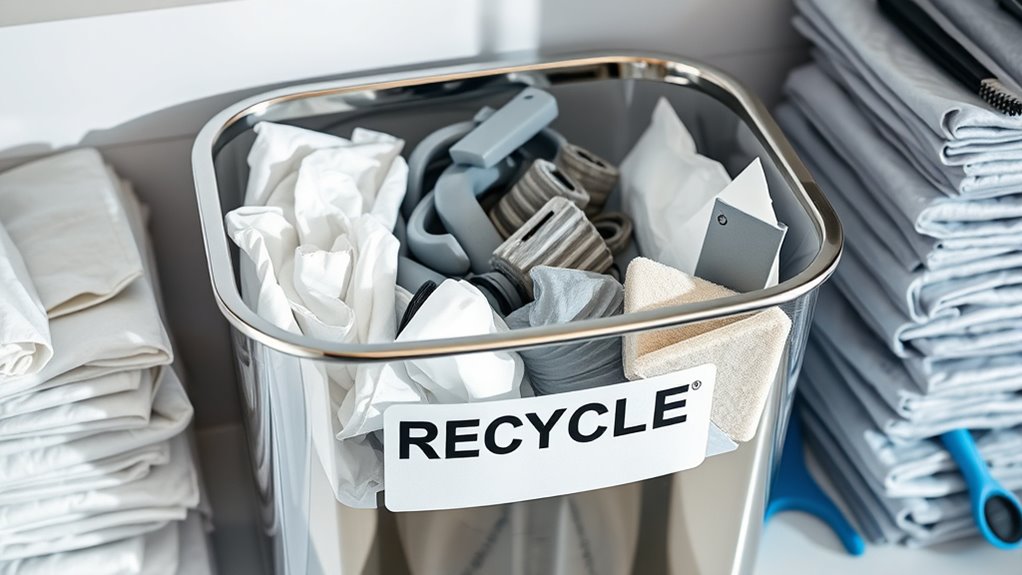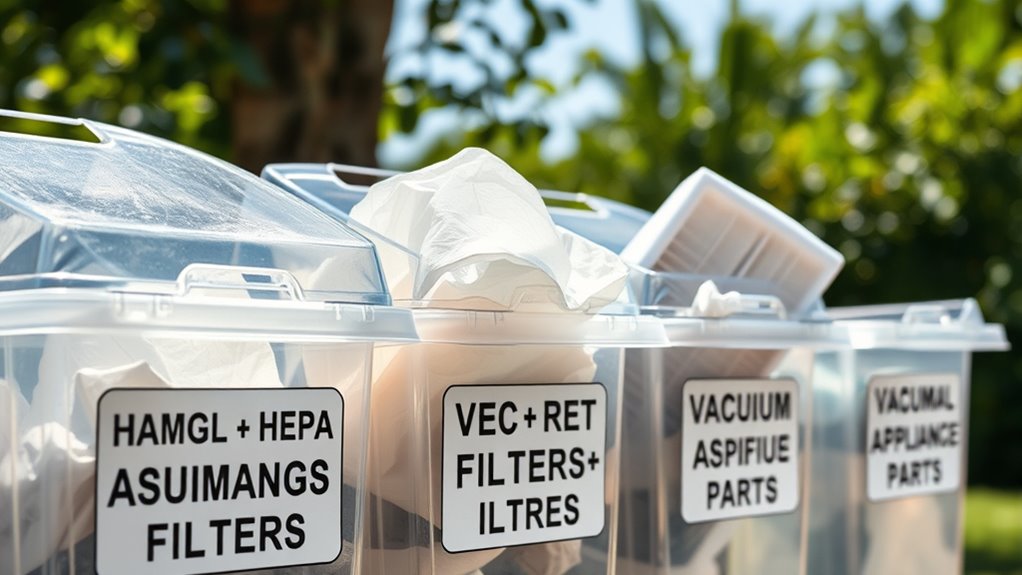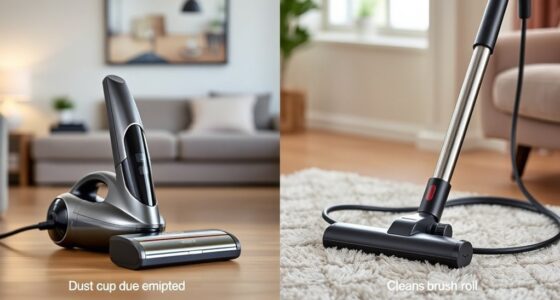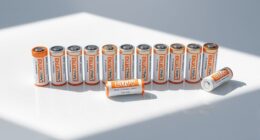To dispose of vacuum bags, filters, and parts responsibly, check your local recycling guidelines first. Recycle paper or certain plastics if accepted and make sure bags are properly sorted. Seal used filters and hazardous parts to prevent leaks and avoid burning or composting them. For contaminated or hazardous items, use designated collection sites or special disposal services. Following these steps helps protect the environment and your health—keep going to discover more tips for safe disposal.
Key Takeaways
- Check local recycling guidelines for vacuum bags, filters, and parts, and sort them accordingly for proper disposal.
- Seal used vacuum bags and filters to prevent leaks and contamination before disposal.
- Use designated hazardous waste collection sites or services for contaminated or chemical-laden vacuum components.
- Recycle filters made from plastics or metals by following manufacturer instructions or local recycling programs.
- Avoid burning or composting vacuum bags and parts to prevent environmental harm and health risks.

Disposing of vacuum bags properly is vital for maintaining a clean and safe home. When your vacuum bag reaches full capacity or shows signs of wear, it’s tempting to toss it in the trash and forget about it. However, understanding how to dispose of these bags correctly can make a significant difference in protecting the environment and your community. One of the first things to consider is recycling tips that can help you reduce waste. Many vacuum bags, especially those made from paper or recyclable plastic, can be disposed of in a more eco-friendly manner if sorted correctly. Check your local recycling guidelines to see if vacuum bags qualify; some communities accept certain types of plastics or paper in their curbside recycling bins. If you’re unsure, it’s best to avoid tossing vacuum bags in the regular trash to prevent unnecessary landfill buildup and promote waste reduction.
It’s also vital to recognize that vacuum bags may contain hazardous waste, especially if you vacuum up substances like mold spores, fine dust, or certain chemicals. These contaminants can pose health risks if improperly disposed of. To handle hazardous waste responsibly, you should seal used vacuum bags tightly in plastic bags or containers to prevent leaks or airborne particles during disposal. Never burn vacuum bags or dispose of them in compost bins, as this can release harmful substances into the air or soil. Instead, consult local waste management authorities for specific disposal procedures related to hazardous waste. Many communities have designated collection sites or special pickup services for hazardous materials, ensuring they’re handled safely and correctly.
Additionally, some vacuum bags are made from materials that could be recycled if properly sorted, reducing overall waste. When it comes to filters and parts, the same principles apply. Some filters are recyclable, especially those made from certain plastics or metal components. Always read the manufacturer’s instructions for disposal or recycling options. If recycling isn’t an option, dispose of filters in the trash, but again, seal them properly to contain dust and particles. Avoid disposing of vacuum parts in general waste if they contain hazardous materials or electronic components that could harm the environment. Instead, look for recycling programs that accept electronic waste or hazardous materials to ensure proper handling.
Ultimately, being mindful of how you dispose of vacuum bags, filters, and parts not only keeps your home safe but also contributes to environmental sustainability. Recycling tips can help you minimize waste, and understanding hazardous waste disposal ensures you’re doing your part to prevent pollution and health hazards. Proper disposal methods may also include considering the hazardous waste category for particularly contaminated bags. Taking these steps might require a little extra effort, but it’s a responsible choice that benefits everyone and helps preserve the planet for future generations.
Frequently Asked Questions
Are Vacuum Bags Considered Hazardous Waste?
Vacuum bags are generally not considered hazardous waste, but proper disposal is essential. For vacuum bag disposal, you should follow hazardous waste handling guidelines if the bag contains hazardous materials like certain chemicals or biological contaminants. Always check local regulations, and if unsure, treat the bag as hazardous waste to prevent environmental contamination. Proper disposal helps protect your health and the environment.
Can Vacuum Filters Be Composted?
Is your vacuum filter a green hero or a villain lurking in the waste? Unfortunately, most filters can’t be composted because they contain synthetic materials and trapped debris. Instead, consider biodegradable alternatives for future use. For DIY filter disposal, remove any debris, then check local guidelines. Proper disposal minimizes environmental impact, turning waste into a responsible act rather than an ecological villain. Always stay informed to protect our planet.
How Do I Recycle Old Vacuum Parts?
You can recycle old vacuum parts by checking local recycling programs for vacuum bag recycling and filter disposal options. Remove any non-recyclable components, like plastic or metal, and clean them if needed. For vacuum bags, see if your community accepts them in recycling or composting. Otherwise, consider repurposing or safely discarding them. Always follow manufacturer guidelines and local regulations to guarantee responsible disposal of vacuum parts.
Is There a Special Disposal Method for HEPA Filters?
Hepa filters are more than just trash; they’re tiny superheroes trapping allergens! For HEPA filter disposal, don’t toss them in regular trash. Instead, check if your local waste authority offers filter recycling programs—they might turn your old filter into something new. If no programs exist, wrap the filter securely in plastic and dispose of it in the trash to prevent allergen release. Always prioritize eco-friendly disposal methods!
What Should I Do if a Vacuum Bag Contains Hazardous Materials?
If your vacuum bag contains hazardous materials, you need to follow hazardous waste disposal guidelines. First, wear gloves and a mask for safety. Seal the bag tightly to prevent leaks. Check your local regulations for proper disposal procedures, which may involve taking it to a designated hazardous waste facility. Never throw hazardous waste in regular trash, to protect the environment and public health. Always prioritize safe, responsible disposal.
Conclusion
Remember, disposing of vacuum bags, filters, and parts responsibly helps protect the environment. Did you know that over 1.5 million tons of vacuum waste end up in landfills every year? By recycling or properly discarding these items, you’re reducing waste and supporting sustainability. Take a moment to check your local disposal guidelines—small actions make a big difference. Together, we can keep our planet cleaner and healthier for future generations.









